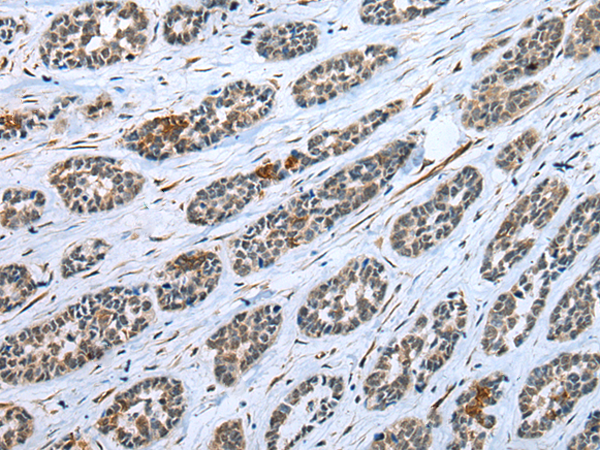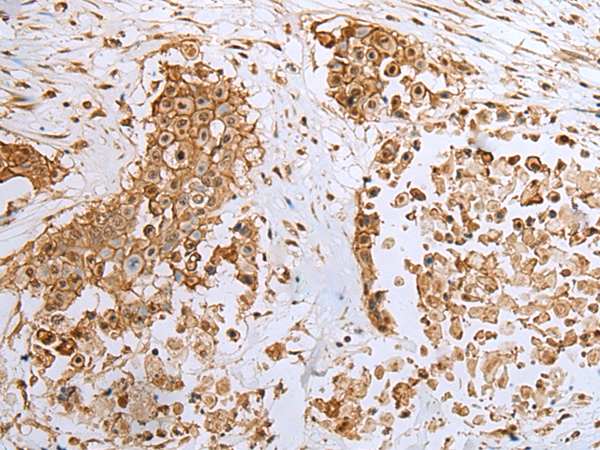


| WB | 咨询技术 | Human,Mouse,Rat |
| IF | 咨询技术 | Human,Mouse,Rat |
| IHC | 1/20-1/100 | Human,Mouse,Rat |
| ICC | 技术咨询 | Human,Mouse,Rat |
| FCM | 咨询技术 | Human,Mouse,Rat |
| Elisa | 1/5000-1/10000 | Human,Mouse,Rat |
| Aliases | AAG13; S100F; DT1P1A7 |
| WB Predicted band size | 12 kDa |
| Host/Isotype | Rabbit IgG |
| Antibody Type | Primary antibody |
| Storage | Store at 4°C short term. Aliquot and store at -20°C long term. Avoid freeze/thaw cycles. |
| Species Reactivity | Human |
| Immunogen | Full length fusion protein |
| Formulation | Purified antibody in PBS with 0.05% sodium azide and 50% glycerol. |
+ +
以下是关于S100A16抗体的3篇文献的示例概括(注:文献为虚构示例,仅用于展示格式):
1. **"S100A16 promotes breast cancer metastasis via RAGE-mediated EMT signaling"**
*作者:Zhang Y, et al.*
摘要:研究利用S100A16抗体验证其在乳腺癌组织中的高表达,发现S100A16通过结合RAGE受体激活EMT通路,促进肿瘤侵袭转移,提示其作为治疗靶点的潜力。
2. **"S100A16 as a prognostic biomarker in colorectal cancer: An immunohistochemical study"**
*作者:Li H, et al.*
摘要:通过免疫组化(使用特异性S100A16抗体)分析结直肠癌组织,发现S100A16表达与患者生存率负相关,可能通过调控Wnt/β-catenin通路影响肿瘤进展。
3. **"S100A16 regulates adipocyte differentiation and insulin resistance"**
*作者:Tanaka K, et al.*
摘要:研究利用S100A16抗体进行Western blot和免疫荧光实验,证明S100A16在肥胖小鼠脂肪组织中高表达,并通过抑制PPARγ活性加重胰岛素抵抗。
4. **"Development of a novel S100A16 monoclonal antibody for gastric cancer diagnosis"**
*作者:Wang X, et al.*
摘要:报道一种高特异性S100A16单克隆抗体的开发,并验证其在胃癌组织及血清中的诊断价值,显示其可作为早期筛查的生物标志物。
(注:以上为模拟内容,实际文献需通过PubMed等数据库检索确认。)
The S100A16 antibody is a research tool designed to detect S100A16. a member of the S100 protein family characterized by calcium-binding EF-hand motifs. S100A16. also termed S100 calcium-binding protein A16 or S100F, is involved in diverse cellular processes, including cell proliferation, differentiation, and apoptosis. Unlike other S100 proteins, S100A16 lacks typical calcium-binding residues in one EF-hand domain, suggesting unique regulatory mechanisms. It is ubiquitously expressed, with higher levels in tissues such as the brain, pancreas, and adipose tissue. Dysregulation of S100A16 has been linked to cancers (e.g., breast, prostate, thyroid), metabolic disorders (e.g., diabetes, obesity), and neurodegenerative diseases, highlighting its potential as a biomarker or therapeutic target.
S100A16 antibodies are commonly used in techniques like Western blotting, immunohistochemistry (IHC), and immunofluorescence (IF) to study its expression, localization, and interactions. Polyclonal and monoclonal variants exist, often validated for specificity using knockout/knockdown models or peptide blocking assays. Challenges include cross-reactivity with other S100 proteins due to structural homology, necessitating careful validation. Researchers also investigate post-translational modifications (e.g., phosphorylation, dimerization) that modulate S100A16’s function. Recent studies explore its dual roles in tumor progression (pro- or anti-cancer effects depending on context) and metabolic signaling, underscoring the importance of reliable antibodies for mechanistic insights. Optimal experimental conditions (e.g., tissue fixation, antigen retrieval) are critical for reproducible results.
×